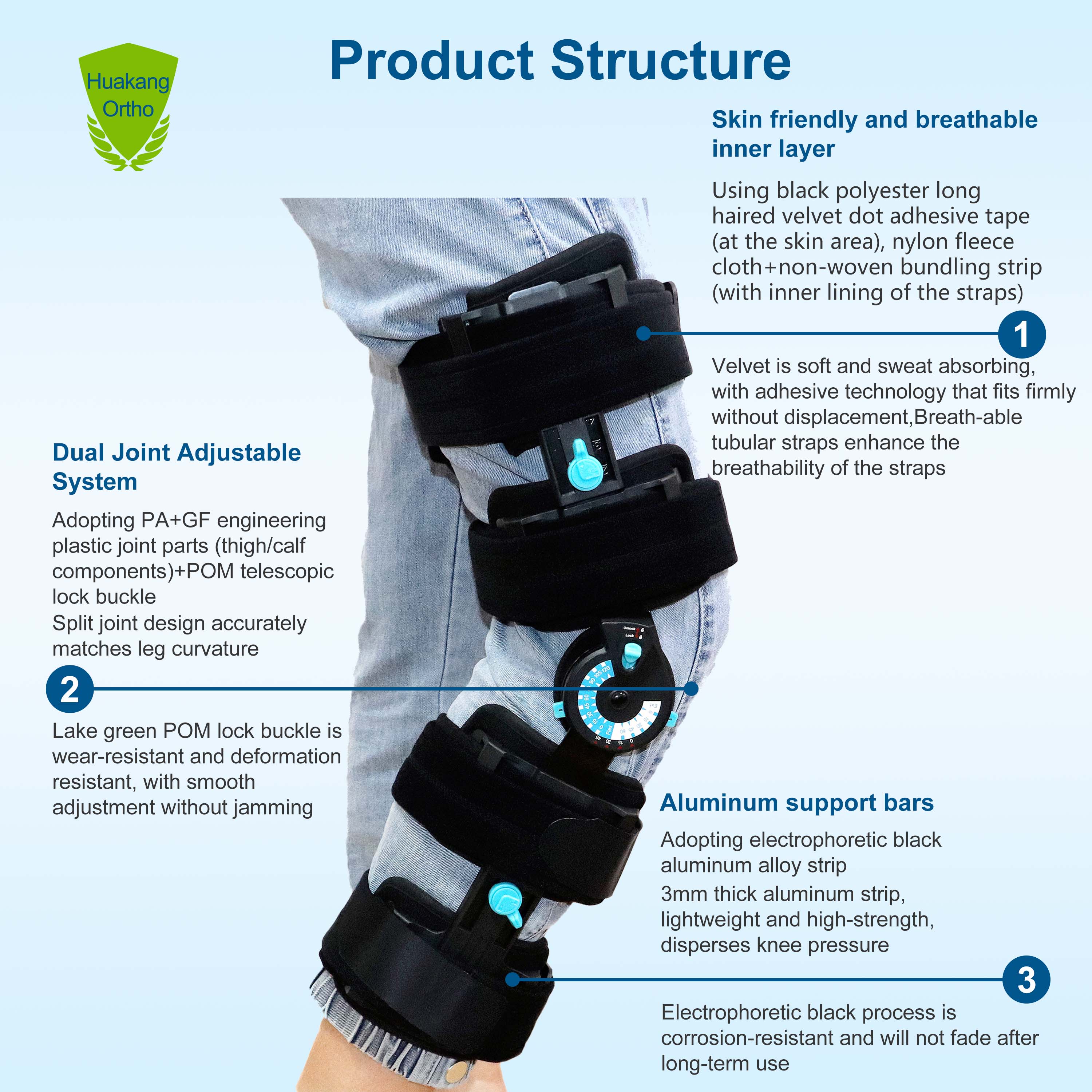China manufacturer with FDA/CE/MDR/ISO13485
- call us :18030239913
- email us : sales3@huakangortho.com
Whether you’re an athlete nursing a minor knee ache, a senior managing arthritis, or someone recovering from surgery, you’ve probably wondered: “What does a knee brace actually do?” It’s easy to write them off as “just support,” but knee braces are science-backed tools that target specific knee issues—stabilizing joints, easing pain, speeding recovery, and protecting long-term knee health. Let’s break down their key functions, how they help different conditions, and how to pick the right one—no sales pitches, just practical insights.
A knee brace works with your knee’s anatomy—ligaments, cartilage, and muscles—to fix biomechanical imbalances that cause discomfort or instability. Here’s what it actually does:
The knee relies on ligaments (ACL, MCL, etc.) to stay aligned, but injury or weakness can make it “give out” during simple tasks like climbing stairs. A well-fitted brace adds external support to limit harmful movement:
• Hinged braces: Ideal for ligament strains (e.g., mild MCL sprains). They have side stabilizers to prevent inward/outward bending—perfect for a basketball player returning to practice.
• Wraparound braces: Great for mild instability (e.g., post-workout soreness). They hug the knee to reduce “shifting” during walking or light exercise.
Science check: Studies show hinged braces cut ACL re-injury risk by 50% in athletes, proving stability isn’t just temporary protection—it preserves joint health long-term.
For chronic pain (like osteoarthritis) or cartilage damage, braces act as “pressure redistributors.” When cartilage wears down, bones rub together—causing inflammation and pain. Braces shift weight away from the sore spot:
• Unloader braces: The top choice for arthritis. They use straps and hinges to tilt the thigh bone (femur) away from damaged cartilage (usually the inner knee), moving pressure to the healthier outer side.
• Soft sleeves: Good for early-stage arthritis. They add gentle compression to ease mild discomfort during daily tasks (e.g., grocery shopping).
Research backup: A study in the Journal of Orthopaedic Research found unloader braces reduce knee contact pressure by 30-50%—no painkillers needed.
After surgery (ACL reconstruction, meniscus repair) or acute injuries, your knee needs controlled movement to avoid overstretching healing tissues. A rigid hinged knee brace lets doctors set precise range-of-motion (ROM) limits—like 0-60 degrees of bending in early recovery. This ensures the knee heals in the right position, preventing scar tissue from forming incorrectly.
Patients often say these braces make them feel safer walking or doing physical therapy—speeding up recovery without fear of setbacks.
Soft neoprene sleeves or compression braces gently squeeze the knee, increasing blood flow to damaged tissues. More oxygen and nutrients mean faster healing, while better waste removal cuts down on swelling.
A study in the British Journal of Sports Medicine found compression braces reduce swelling by 20% in acute sprains—helping you get back to walking, running, or cycling sooner.
Different knee issues need different braces. Here’s how to match the tool to your problem:
A mild sprain or strain needs protection from further damage. Compression sleeves or strap-style braces limit excessive movement, so torn fibers don’t get worse. For example:
• A hiker with a mild knee strain can wear a neoprene sleeve (like the Huakang Ortho Compression Knee Sleeve) to reduce swelling and stabilize the joint during trails.
The goal here? Let your body focus on repairing tissue—no extra strain.
Arthritis pain comes from bone-on-bone friction, so braces target pressure redistribution:
• Unloader braces: Best for moderate-to-severe pain. They shift weight away from damaged cartilage—great for anyone who struggles with walking or standing for long periods. Try the Huakang Ortho Unloader Knee Brace for targeted pressure relief.
• Soft compression sleeves: Good for early-stage arthritis. They add warmth and mild support, easing stiffness in the morning.
Both address the root cause of pain (friction), not just mask it.
After surgery, a rigid hinged knee brace is non-negotiable. It controls ROM to protect healing tissues and gives you confidence to put weight on your knee. For example:
• Someone recovering from ACL reconstruction might use the Huakang Ortho Rigid Hinged Knee Brace, which lets doctors adjust ROM limits as healing progresses (from 0-60 degrees to full movement over time).
These braces turn “fear of moving” into “confidence to heal.”

scan to wechat:
